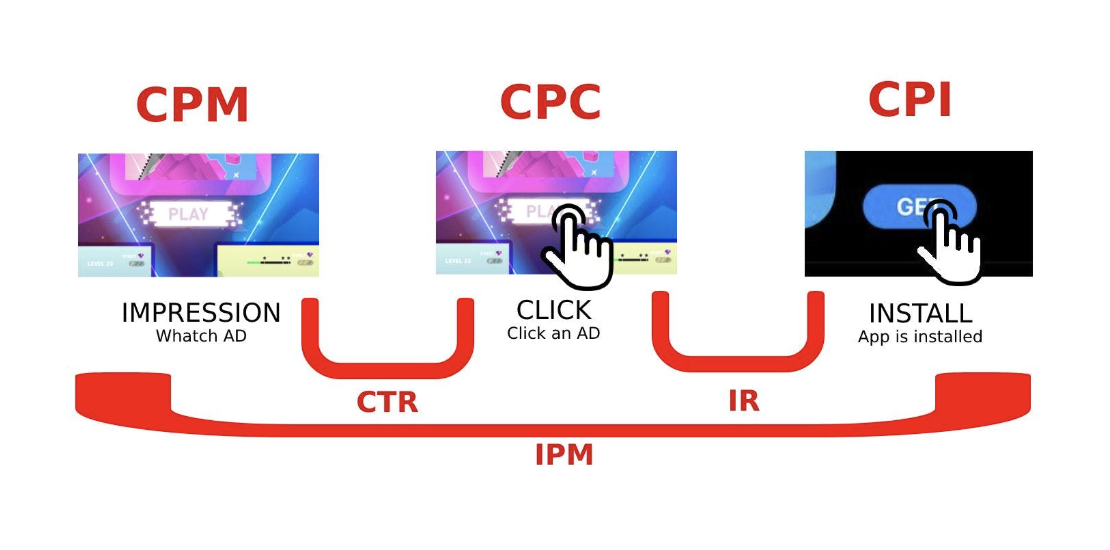Article published on April 26th, 2021 at hackernoon.com
When developers work on a game, they need to test the validity of their ideas. Usually, hyper-casual game publishers test product metrics even before developers start making the actual game. The most important thing is to find out if users will install the game and to do so almost for free.
To get started, all you need is a game idea and a simulated video of its future gameplay. As soon as the developer provides the video, publishers use it to run ads and test how expensive it may be to attract users to the game.
In order to evaluate the demand, publishers use a variety of metrics, such as CTR, CPM, CPC, and the main one known as CPI. These terms might look confusing at the first glance, but all of them are quite simple to understand.
The standard user acquisition process consists of three steps:
- The user sees an ad. This action is called an impression.
- The user clicks on the ad to navigate to the app store page to download the application.
- The user installs the app.

The quality of each step can be assessed with the following metrics.
CTR: Click-Through Rate
Not all users who see an advertisement will click on it. But those who do are of primary interest to publishers. The percentage of users who have clicked on the ad after seeing it is called Click Through Rate or CTR. Marketers also call this term ad conversion, which is the ratio of clicks to impressions.
IR: Install Rate
Not all users who have clicked on the ad will go on to download the app. But those who do, are taken into account in Install Rate (IR) calculation. IR is the ratio from clicks to installs. It means how many clicks on an ad it takes to lead to one installation of an app.
The target Install Rate is 60-70%. A level of 50-60% is a low average. Anything below 50% is considered bad. If IR is below the target value, it means that people stop at the store page and don't convert to install the app. This happens if users don't see the expected screenshots and icons seen in the gameplay adverts. Low ratings and bad reviews might affect the installation decision, too.
In monetization tests, video ads are purposely made so that the user accidentally clicks on them. These types of ads have a much higher CTR and much lower IR.

Below, let's take a look at metrics that are based on money. When we add cost calculation, the rest of the indicators come into play, too.
CPM: Cost Per Mille
When the advertisement is set up, the ad network charges money for each display of the ad. Usually, the amount of impressions is so high that it is more convenient to count the amount per 1,000 impressions. For this purpose, marketers use Cost Per Mille (1,000), or CPM. This metric shows how much it costs to show an ad to potential users 1,000 times.
CPC: Cost Per Click
This metric shows the actual price you pay for each click on the ad. Marketers call this number Cost Per Click or CPC. Cost Per Click is calculated by multiplying the Cost per Mile and Click Through Rate, so CPC = CPM * CTR.
CPI: Cost per Install
This is the main metric that publishers and developers focus on. CPI stands for Cost per Install and means how much does it cost you to acquire each new user. Cost per Install is calculated by multiplying Cost Per Click and Install Rate, so CPI = CPC* IR. Now, the picture with three basic actions is completed:

All of these might be tricky for a newbie developer. This is why hyper-casual publishers and developers usually work together. While the engineers are responsible for the technical side of the process, publishers run the advertising and testing.
For example, at Ducky, developers test video ideas of the hyper-casual game. They send us prototypes and receive all those metrics and market feedback results in 24 hours.
However, for a proper understanding of testing results, it's not enough to know the meaning of digital marketing abbreviations. It is also important to understand which values of CPM, CTR, and CPI indicate that the game is worth releasing and scaling.
Understanding how things work allows developers to hack their way to their first "hit" and further "hits" faster. And speed is crucial in this genre.

-02.png)

-01.png)